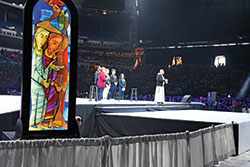National Catholic Youth Conference 2019
Monk creates images to help youths encounter Christ

Franciscan Friar of the Renewal Father Agostino Torres and a group of youths lead National Catholic Youth Conference participants in a period of lectio divina (“holy reading”) prayer on Nov. 22 in Lucas Oil Stadium in Indianapolis. An image depicting part of the story from the Gospel of St. Luke about the disciples on the road to Emmaus created by Benedictine Brother Martin Erspamer sits adjacent to the main stage during the prayer session. (Photo by Sean Gallagher)
By Sean Gallagher
Lucas Oil Stadium in Indianapolis might be described as a cathedral of football since tens of thousands of Indianapolis Colts fans faithfully fill it for the National Football League team’s home games.
But the organizers of the National Catholic Youth Conference (NCYC) sought to make the massive stadium as much like an actual cathedral as they could for the 20,000 Catholic youths from across the country who attended the biennial event on Nov. 21-23.
Instead of cheering touchdowns, they wanted the youths to enter deeply into prayer and give praise and worship to God.
To that end, the organizers commissioned nationally-known liturgical artist Benedictine Brother Martin Erspamer, a monk of Saint Meinrad Archabbey in St. Meinrad, to create five stained glass-like images of the story from the Gospel of St. Luke of the disciples on the road to Emmaus (Lk 24:23-35).
Brother Martin spoke with The Criterion about his work in the days leading up to NCYC. In a way, he compared his art to the youths who journeyed from their homes across the country to attend the conference.
“I hope they move them to pray and enter into the mystery of the Lord revealing himself,” Brother Martin said. “These things tend to have for me a life of their own.
“They’re like my children, in sense, in that I work on them and I agonize over them. And, at a certain point, you have to cut them loose. Then, after they’re loose, they’re on their own.”
The images, originally 28 inches tall and 10 inches wide, were created with transparent ink on paper. In the stadium, they were projected onto panels hung far above the stage that were 28 feet tall and 10 feet wide. They were also on panels 8 feet tall and 3 feet wide that were brought adjacent to the stage itself during different sessions of the conference.
The images of the disciples on the road to Emmaus were chosen in particular because the participants were led during the conference in prayerfully meditating on that Gospel passage.
Paul Sifuentes, archdiocesan director of youth ministry and an NCYC organizer, is convinced that beauty is an attractive way to invite young people to enter into the faith and explore it within their hearts more deeply.
“I think they need to know that faith and beauty are companions on the journey,” Sifuentes said. “They don’t just intersect for a moment. Our faith should produce beauty.”
He reflected that sacred art is an effective means to help youths not so much learn about Christ, but to meet him.
“So often in our Church recently, we have often concentrated on how we can best tell someone about Christ,” Sifuentes said. “And we absolutely need to tell people about Christ and be able to tell a story.
“But we also need to know of the ways that we can say, ‘This is the person who encountered me in incredible ways. Let me help you encounter him as well.’ ”
The form of prayer used in the conference in connection to the images was lectio divina (“holy reading”), an ancient spiritual practice fostered for more than 1,000 years in monastic communities like Saint Meinrad Archabbey, in which people slowly read scriptural texts and approach them prayerfully from different perspectives.
The contemporary images created by Brother Martin are in many ways modeled after the modes of artistic expression used in medieval stained-glass windows.
Brother Martin said that Saint Meinrad is a place where ancient traditions of faith, including art, lectio divina and Gregorian chant, are alive and form the faith of the monks and many who visit the monastic community.
“Certainly all of those traditions are alive here,” Brother Martin said. “I consider what I do and what we do as being connected to the ancient traditions of the Church. In a sense there’s one foot that is stabilized by the past but then the other foot is moving into the future.”
Sifuentes said that bringing together Scripture, a form of prayer used for more than 1,000 years and art rooted in the age-old traditions of the Church shows that these traditions are alive today and can speak to contemporary Catholic youths.
“The reason that they are alive is that they produce encounters with the living God,” he said. “Art, beauty, lectio divina—I think these are ways where we get out of the way and let them encounter God himself.” †
See more coverage from NCYC 2019
